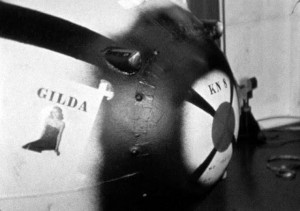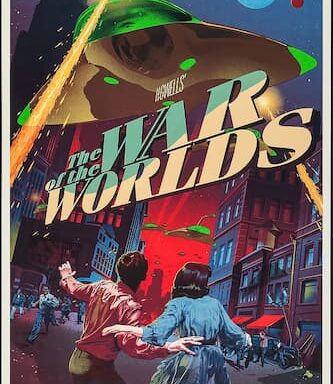Rita Hayworth is still one of the most iconic pop culture figures of the 20th century and one of the four or five most iconic ‘Hollywood’ stars of the last century.
A few weeks ago marked the thirtieth anniversary of her death in 1987, and I wanted to take a moment to draw attention to some of the curious things relating to Hayworth and also to generally reflect on her.
Her story is an extraordinary, though not particularly happy, one; one that straddles the ‘Golden Age’ of Hollywood and cinema, the Second World War, and even becomes a real-life story of a princess, is punctuated by high-profile marriages and dysfunctions, and eventually finishes as a sad story of early onset Alzheimer’s.
The fact that Hayworth developed Alzheimer’s very young – and a time when the illness wasn’t very well understood – is the saddest aspect of her story. For much of her final years, it is said she didn’t really even know what being ‘Rita Hayworth’ meant and didn’t fully even remember her past.
My own fascination with Rita Hayworth began not with any of her films, but with a feature-length documentary film about her life I remember seeing on TV a number of years ago. It was narrated by Kim Basinger and called simply Rita – The Biography of Rita Hayworth; I remember being entranced by it when it was on in the very late hours of Christmas Day (or early hours of Boxing Day) about twelve years ago.
Prior to that, I only really knew Rita Hayworth as an iconic image (literally, the image of Gilda), as the inspiration for Jessica Rabbit, and as the poster on the prison cell wall in The Shawshank Redemption (as it happens, Stephen King‘s original story was actually titled ‘Rita Hayworth and the Shawshank Redemption’).
I saw Gilda for the first time shortly after that – and I watched it three times in the space of a fortnight.
One curious thing about Rita Hayworth is that, considering her enormous stature in Hollywood icon terms, her filmography isn’t necessarily all that impressive: there are few major films or roles that can be cited to confirm her as a standout actress in the way that can be done with, say, Katharine Hepburn or Elizabeth Taylor.
Gilda is the closest thing – and her performance in Gilda is, beyond doubt, unforgettable. I would then argue that her performance in Lady from Shanghai remains both compelling and iconic.
But it’s fair to say that Rita Hayworth’s enduring stardom is more about her image and about her relationship to the time she lived in than necessarily about her on-screen body of work. Her fame, for example, was massively enhanced by the preponderance of her pin-up images in soldiers’ barracks during the war.
Her connection to war also took another form.
The image of her face was famously glued onto an atomic bomb, which was dropped on the Bikini Atoll (in a Pacific Ocean island) during a test in 1946.
This actually occurred while Gilda – the film-noire classic she would become most famous for – was showing in cinemas. Hayworth herself was deeply offended by the use of her images on the bomb. Orson Welles, her husband at the time, told the biographer, Barbara Leaming, that the angriest he had ever seen Rita “was when she found out that they’d put her on the atom bomb. Rita almost went insane, she was so angry. She wanted to go to Washington to hold a press conference, but Harry Cohn wouldn’t let her because it would be unpatriotic.”
She was absolutely horrified about her likeness being attached to a weapon of mass destruction.

This issue of her image and perception appears to have been something that troubled her for a long time.
From all accounts, she wasn’t particularly happy with the almost mythic popular image she was tied to in people’s minds and didn’t identify with that image. This was obviously what she meant in her oft-quoted line about people wanting ‘Gilda’ but having to settle for Rita. Leaming had said that “Rita Hayworth hated being Rita Hayworth”; and, from all evidence, this was probably true.
The changeful nature of her image or identity is something that permeates much of her story – often being something in the control of other people and not Hayworth herself.
This can be seen, for example, in how Orson Welles would later subvert her iconic image in Lady From Shanghai, or in the fact that her real name was actually Margarita Carmen Cansino – but that she had been made to change her name in order to be assimilated into Hollywood. Her real name was too foreign-sounding and it was considered necessary to Americanise her identity for mass appeal. She also underwent surgery and electrolysis to transform her appearance.
Her manager, Harry Cohn, would – like most Hollywood handlers in those days – try to exercise enormous control over her image, work and life. As was common then, Hayworth wasn’t a free agent, but was considered the property of the studio. It later emerged that Hayworth had to spend a lot of time fighting off physical advances from Cohn. She was also apparently abused by her father in the earlier days.

Rita Hayworth’s story, like some of the other most famous screen actresses of the early-to-mid twentieth century (particularly Judy Garland and Marylin Monroe), does seem to be framed in sadness; that’s certainly the impression you get from any serious reading on her life and particularly from Barbara Leaming’s biography of her, If This Was Happiness, which focuses a lot (some might say excessively) on sexual abuse at a young age and childhood trauma and frames most of the rest of Hayworth’s life within that context.
In fairness to Leaming, the apparent confirmation of the violent incest of Hayworth’s early life appeared to come from no less a source than Orson Welles, who admitted Hayworth had been violently abused as a youth.
A significant amount of time before Grace Kelly was portrayed as the real life ‘fairytale princess’ (when she left film and married into the Monaco royal family, becoming ‘Princess Grace’), it was actually Hayworth who was the original real life ‘movie star to princess’ story. It was in 1948 that Hayworth abandoned her movie career to marry the Prince Aly Khan (a son of Sultan Mahommed Shah, Aga Khan III, the leader of the Muslim Ismaili sect).
Khan served as the Permanent Representative of Pakistan to the United Nations, where he also became a vice president of the General Assembly. Hayworth’s marriage to him, however, was apparently fraught with difficulty and unhappiness, and they inevitably divorced.
But Hayworth’s decision to leave Hollywood caused such consternation that an article was even published calling for a boycott of Hayworth and essentially suggesting she not be allowed to return to films.
Of her several marriages (all of which apparently ended badly), the most famous was her marriage to another 20th century film legend, Orson Welles. The relationship between Welles and Hayworth was by all accounts difficult.

Welles had once sawed Hayworth in half as part of a magic act; but that was no controversy and certainly didn’t raise as much interest as what he did with her in Lady From Shanghai. The film, in which he famously cast his wife as ‘Elsa’, had him controversially (at the time) making her cut her iconic long red hair and bleach it blonde for the part. It was seen by some as Welles trying to subvert, dismantle or deconstruct Hayworth’s iconic sex-symbol image – a number of fans (and critics) didn’t react kindly to this at all.
The film was panned by critics in America at the time of release; though it is now considered an absolute classic, even for its flaws, and even makes polls for some critics’ all-time greatest movies. The closing hall of mirrors sequence has become iconic in its own right and has been mimicked or paid homage to a number of times in other peoples’ work. But the key genius of the film is arguably Hayworth’s performance and in particular the way Welles was able to re-frame and reinvent Hayworth’s on-screen image for a moment.
Most people have seen Gilda; but I would recommend seeing Lady from Shanghai at least once too. It is both a classic piece of film noire, as well as a fascinating Orson Welles movie; and in addition to all that, it features a very memorable performance from Hayworth. For all of those reasons, it warrants more attention and stature than it often gets.
Welles and Hayworth finalised their divorce plans shortly after completing the film.
However, there is little doubt that both of them retained great affection towards each other for many years later. A bunch of the love letters and drawings that Welles sent to Hayworth were much later discovered in a secret compartment of her make-up case, indicating that – despite their falling out and divorce – she nevertheless valued them and had wanted to hold onto them.
These had included watercolor sketches attempting to portray an unhappy husband separated from his wife. “I suppose most of us are lonely in this big world,” Welles had written in one of the letters, “but we must fall tremendously in love to find it out.”
In the interview he did on the Merv Griffin Show (the evening before his death) in 1985, Welles called Hayworth “one of the dearest and sweetest women that ever lived”.
But the last times Welles had met Hayworth, he claimed she’d had trouble recognising who he was. Hayworth was barely 60 when she was diagnosed with Alzheimer’s in 1980, but had been suffering from its effects for longer than that. Most agree that she may have first began exhibiting signs of the illness as far back as the 1940s when she would have difficulty remembering lines.
For many years, Hayworth’s symptoms and behaviour were mistakenly attributed to alcohol.

However, her experiences and her slow deterioration are credited with having massively transformed public perception and understanding of Alzheimer’s at a time when the condition still appeared to be poorly understood.
The title of Leaming’s Hayworth book ‘If This Was Happiness’ actually came directly from her conversations with Orson Welles, who had told her of his own dismay when Hayworth had told him that their brief marriage in the 1940s had been the closest she had ever come to happiness; prompting him to wonder how bad the rest of her life must’ve been if she regarded that brief period as ‘happy’.
Rita Hayworth died in May 1987, aged 68; and has remained a massive cultural icon and symbol.
In an article that I said at the start was to mention some of the curious things about Hayworth, her funeral itself has one last curiosity attached to it (for me anyway): one of her pallbearers was Ricardo Montalban, perhaps most famous pop-culturally as the super-villain ‘Khan Noonien Singh’ in the Star Trek mythology. Actually, she and Montalban had a friendship from the 1965 movie The Money Trap, in which they both starred. I haven’t seen that movie; it’s among a number of Hayworth movies I’ve yet to see – but that’s something I intend to do over many years.
Which, for a woman who’s been dead thirty years (and who’s professional career was already over by the time I was born), says something about her impact and cultural longevity.
See all FILM posts here.





Compelling read, makes me want to run to Gilda and The Lady of Shanghai. The 30-40’s, even through into the 50’s, were the era of era for films, for me. Outrageous atmosphere while something very real about, even with show-time sets and scripts. Times of turmoil and yet out of war and depression – a certain ease and life affirming. An escape into… humanity thriving. Rita all radiant. Honest, self-effacing and so funny. What presence and poise. Somehow could be all up-front and panache without looking like trying. Reminds me of a sparkling gal recently met. Thanks for the memory lane and lovely Rita.
Should add of course, the sadness behind this is… sad. Let’s hope Rita found much good in her fantastic acting and something good in life.
https://www.youtube.com/watch?v=t7TqPv1QowQ